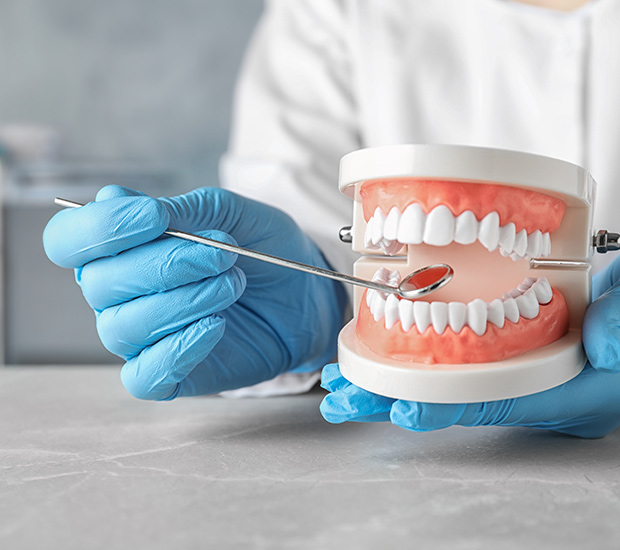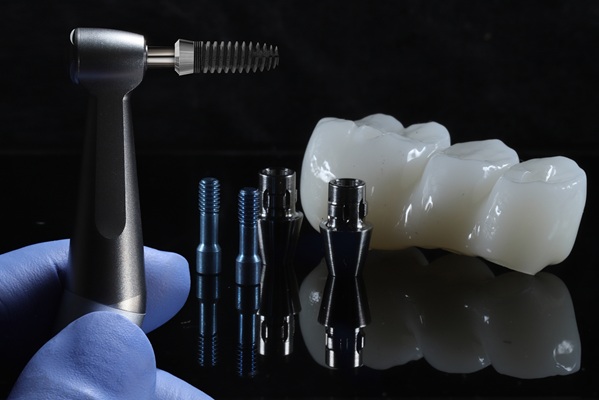Frequently Asked QuestionsRosenberg, TX
What causes bad breath?
What happens on the first appointment for exam and x-rays?
As you are welcomed into the office, you will be asked to fill out your health and insurance information ( that you have the option to download from this website and bring it into the office to expedite the process). Once your information is verified and entered into the computer, you will be asked by our friendly staff to come to the dental chair to take some radiographs that reveal the internal structure and reveal any carious activity (cavities or holes inside the teeth), periodontal disease (bone loss) or infection within the teeth or bone. At KRB we offer digital X-rays, which minimize the radiation, are faster and more comfortable to take. We also offer the panoramic full face x-rays as well as the 3-D CBCT.
The x-rays are a diagnostic tool used by the dentist to perform a comprehensive clinical oral examination. Once the dentist completes the evaluation, the dentist and the assistant go over their findings and their recommendations, the front office team will enter the proposed treatment plan and discuss the options with you. The experienced staff at KRB will discuss your issues and help you understand your needs and priorities. They will work with you in taking care of any and all issues. In most cases, same day treatment is offered.
What should I do if my face is swollen?
You must come into the office immediately or call our after-hours helpline. We will either drain the pus from the abscess and, or place you on antibiotics.
What should I do if my tooth breaks?
If the tooth completely falls out of the mouth, do not scrub it, rinse it in water and place in a cup of milk or saline and bring it into the office within 2 hours. We can try to replant the tooth and splint it to the other teeth for reinforcement for about 6 weeks till it is stabilized. For any further questions please contact us or leave a question in through our Contact Us section.
Where can I find new patient forms?
Our team will text you the new patient forms so that you can complete them. This helps our team get to know you better. We ask that you arrive 15 minutes early to complete your paperwork.
New patients often ask if they can have their teeth cleaned during their first visit. Your dental treatments usually begin with a follow-up visit, often scheduled as soon as the next day. We need to see you first for a comprehensive exam and then schedule adequate time with your hygienist.
What should I do if I have bad breath?
Bad breath (halitosis) can be an unpleasant and embarrassing condition. Many of us may not realize that we have bad breath, but everyone has it from time to time, especially in the morning.
There are various reasons one may have bad breath, but in healthy people, the major reason is due to microbial deposits on the tongue, especially the back of the tongue. Some studies have shown that simply brushing the tongue reduced bad breath by as much as 70 percent.
What may cause bad breath?
- Morning time – Saliva flow almost stops during sleep and its reduced cleansing action allows bacteria to grow, causing bad breath.
- Certain foods – Garlic, onions, etc. Foods containing odor-causing compounds enter the bloodstream; they are transferred to the lungs, where they are exhaled.
- Poor oral hygiene habits – Food particles remaining in the mouth promote bacterial growth.
- Periodontal (gum) disease – Colonies of bacteria and food debris residing under inflamed gums.
- Dental cavities and improperly fitted dental appliances – May also contribute to bad breath.
- Dry mouth (Xerostomia) – May be caused by certain medications, salivary gland problems, or continuous mouth breathing.
- Tobacco products – Dry the mouth, causing bad breath.
- Dieting – Certain chemicals called ketones are released in the breath as the body burns fat.
- Dehydration, hunger, and missed meals – Drinking water and chewing food increases saliva flow and washes bacteria away.
- Certain medical conditions and illnesses – Diabetes, liver and kidney problems, chronic sinus infections, bronchitis, and pneumonia are several conditions that may contribute to bad breath.
Keeping a record of what you eat may help identify the cause of bad breath. Also, review your current medications, recent surgeries, or illnesses with your dentist.
In most cases, your dentist can treat the cause of bad breath. If it is determined that your mouth is healthy, but bad breath is persistent, your dentist may refer you to your physician to determine the cause of the odor and an appropriate treatment plan.
Why is it important to floss to use dental floss?
Brushing our teeth removes food particles, plaque, and bacteria from all tooth surfaces, except in between the teeth. Unfortunately, our toothbrush can’t reach these areas that are highly susceptible to decay and periodontal (gum) disease.
Daily flossing is the best way to clean between the teeth and under the gumline. Flossing not only helps clean these spaces, it disrupts plaque colonies from building up, preventing damage to the gums, teeth, and bone.
Plaque is a sticky, almost invisible film that forms on the teeth. It is a growing colony of living bacteria, food debris, and saliva. The bacteria produce toxins (acids) that cause cavities and irritate and inflame the gums. Also, when plaque is not removed above and below the gumline, it hardens and turns into calculus (tartar). This will further irritate and inflame the gums and also slowly destroy the bone. This is the beginning of periodontal disease.
How to floss properly:
- Take 12-16 inches (30-40cm) of dental floss and wrap it around your middle fingers, leaving about 2 inches (5cm) of floss between the hands.
- Using your thumbs and forefingers to guide the floss, gently insert the floss between teeth using a sawing motion.
- Curve the floss into a “C” shape around each tooth and under the gumline. Gently move the floss up and down, cleaning the side of each tooth.
Floss holders are recommended if you have difficulty using conventional floss.
Daily flossing will help you keep a healthy, beautiful smile for life!
What are porcelain veneers and how can they improve my smile?
Porcelain veneers are very thin shells of tooth-shaped porcelain that are individually crafted to cover the fronts of teeth. They are very durable and will not stain, making them a very popular solution for those seeking to restore or enhance the beauty of their smile.
Veneers may be used to restore or correct the following dental conditions:
- Severely discolored or stained teeth
- Unwanted or uneven spaces
- Worn or chipped teeth
- Slight tooth crowding
- Misshapen teeth
- Teeth that are too small or large
Getting veneers usually requires two visits. Veneers are created from an impression (mold) of your teeth that is then sent to a professional dental laboratory where each veneer is custom-made (for shape and color) for your individual smile.
With little or no anesthesia, teeth are prepared by lightly buffing and shaping the front surface of the teeth to allow for the small thickness of veneers. The veneers are carefully fitted and bonded onto the tooth surface with special bonding cements and occasionally a specialized light may be used to harden and set the bond.
Veneers are an excellent dental treatment that can dramatically improve your teeth and give you a natural, beautiful smile.
What can I do about stained or discolored teeth?
Since teeth whitening has now become the number one aesthetic concern of
many patients, there are many products and methods available to achieve a brighter smile.
Professional teeth whitening (or bleaching) is a simple, non-invasive
dental treatment used to change the color of natural tooth enamel, and is an ideal way to enhance
the beauty of your smile. Over-the-counter products are also available, but they are much less
effective than professional treatments and may not be approved by the American Dental Association
(ADA).
As we age, the outer layer of tooth enamel wears away, eventually revealing a darker or yellow shade. The color of our teeth also comes from the inside of the tooth, which may become darker over time. Smoking, drinking coffee, tea, and wine may also contribute to tooth discoloration, making our teeth yellow and dull. Sometimes, teeth can become discolored from taking certain medications as a child, such as tetracycline. Excessive fluoridation (fluorosis) during tooth development can also cause teeth to become discolored.
It’s important to have your teeth evaluated by your dentist to determine if you’re a good candidate for bleaching. Occasionally, tetracycline and fluorosis stains are difficult to bleach and your dentist may offer other options, such as veneers or crowns to cover up such stains. Since teeth whitening only works on natural tooth enamel, it is also important to evaluate replacement of any old fillings, crowns, etc. before bleaching begins. Once the bleaching is done, your dentist can match the new restorations to the shade of the newly whitened teeth.
Since teeth whitening is not permanent, a touch-up may be needed every several years to keep your smile looking bright.
The most widely used professional teeth whitening systems:
Home teeth whitening systems: At-home products usually come in a gel form that is placed in a custom-fitted mouthguard (tray), created from a mold of your teeth. The trays are worn either twice a day for approximately 30 minutes, or overnight while you sleep. It usually takes several weeks to achieve the desired results depending on the degree of staining and the desired level of whitening.
In office teeth whitening: This treatment is done in the dental office and you will see results immediately. It may require more than one visit, with each visit lasting 30 to 60 minutes. While your gums are protected, a bleaching solution is applied to the teeth. A special light may be used to enhance the action of the agent while the teeth are whitened.
Some patients may experience tooth sensitivity after having their teeth whitened. This sensation is temporary and subsides shortly after you complete the bleaching process, usually within a few days to one weak.
Teeth whitening can be very effective and can give you a brighter, whiter, more confident smile!
How can I tell if I have gingivitis or periodontitis (gum disease)?
Four out of five people have periodontal disease and don’t know it! Most people are not aware of it because the disease is usually painless in the early stages. Unlike tooth decay, which often causes discomfort, it is possible to have periodontal disease without noticeable symptoms. Having regular dental check-ups and periodontal examinations are very important and will help detect if periodontal problems exist.
Periodontal disease begins when plaque, a sticky, colorless film of bacteria, food debris, and saliva, is left on the teeth and gums. The bacteria produce toxins (acids) that inflame the gums and slowly destroy the bone. Brushing and flossing regularly and properly will ensure that plaque is not left behind to do its damage.
Other than poor oral hygiene, there are several other factors that may increase the risk of developing periodontal disease:
- Smoking or chewing tobacco – Tobacco users are more likely than nonusers to form plaque and tartar on their teeth.
- Certain tooth or appliance conditions – Bridges that no longer fit properly, crowded teeth, or defective fillings that may trap plaque and bacteria.
- Many medications – Steroids, cancer therapy drugs, blood pressure meds, oral contraceptives. Some medications have side effects that reduce saliva, making the mouth dry and plaque easier to adhere to the teeth and gums.
- Pregnancy, oral contraceptives, and puberty – Can cause changes in hormone levels, causing gum tissue to become more sensitive to bacteria toxins.
- Systemic diseases – Diabetes, blood cell disorders, HIV / AIDS, etc.
- Genetics may play a role – Some patients may be predisposed to a more aggressive type of periodontitis. Patients with a family history of tooth loss should pay particular attention to their gums.
- Signs and Symptoms of Periodontal Disease
- Red and puffy gums – Gums should never be red or swollen.
- Bleeding gums – Gums should never bleed, even when you brush vigorously or use dental floss.
- Persistent bad breath – Caused by bacteria in the mouth.
- New spacing between teeth – Caused by bone loss.
- Loose teeth – Also caused by bone loss or weakened periodontal fibers (fibers that support the tooth to the bone).
- Pus around the teeth and gums – Sign that there is an infection present.
- Receding gums – Loss of gum around a tooth.
- Tenderness or Discomfort – Plaque, calculus, and bacteria irritate the gums and teeth.
Good oral hygiene, a balanced diet, and regular dental visits can help reduce your risk of developing periodontal disease.





